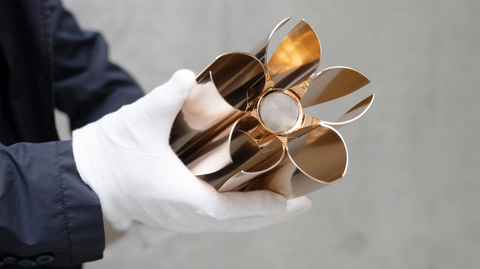How is the Tokyo 2020 Olympics striving for sustainability?
The Olympic Games have always been tied to conversations and concerns about environmental, social, and economic impacts as it is such a massive event involving people all across the globe. The Tokyo 2020 Olympics, which is taking place currently in the summer of 2021 due to the pandemic, has a sustainability concept of “Be better, together – For the planet and the people”, aiming to be the most eco-friendly Olympic games to date, and to become a role model for future Olympic Games.

“The Tokyo 2020 Games has a set of five main sustainability themes for before, during and after the Olympic and Paralympic Games. This includes: climate change; resource management; natural environment and biodiversity; human rights, labour and fair business practice; and cooperation and communications.”
So, what efforts has the Tokyo 2020 Olympics made to create a more sustainable and environmentally-friendly event?
Renewable energy resources at venues
With an effort to promote a zero-carbon Games, electricity used at all venues is derived from 100% renewable energy. Both temporary and permanent venues use power from a renewable electric grid, and are equipped with renewable energy systems like solar power generation systems, solar heat utilization systems, and geothermal heating/cooling systems.
Podiums made from recycled plastic
This is the first time in the history of the Olympic and Paralympic Games where the podium, designed by Japanese artist Asao Tokolo, is made out of recycled plastic – 24.5 tonnes of plastic waste. The Japanese public participated in a nine-month project to collect used plastic that would be recycled and used to 3D print all 98 podiums used at the Olympic Games.
“The underlying philosophy was to create something we would want to keep instead of throwing away as rubbish.” – Asao Tokolo

Olympic medals made from recycled metals
All 5,000 of Tokyo 2020 medals are made from recycled smartphones and electronic devices donated by the public. Over 78,985 tonnes of used smartphones and gadgets were collected, amounting to 32 kg of gold, 3,500 kg of silver, and 2,200 kg of bronze. The ribbons are made from chemically recycled polyester, which has a smaller environmental impact compared to using virgin polyester and newly derived raw materials.

Torch and torchbearer uniform made partly from recycled materials
Japanese designer Tokujin Yoshida designed the torch to open into five sections, resembling the petals of the sakura flower, Japan’s national flower. Around 30% of the 71cm rose-gold torch is made of recycled aluminium from construction waste left from the temporary housing used in the aftermath of the Great East Japan earthquake and tsunami in 2011. Additionally, the uniforms worn by the torchbearers are made from recycled plastic bottles to reduce plastic waste.
“This is a way of transforming materials that witnessed the rebuilding of shattered lives into a symbol of peace, to convey to the world the extent to which the affected areas are recovering, one step at a time.” – Tokujin Yoshida



While the Tokyo 2020 Olympics has a strong sustainability plan and has taken many steps towards ensuring that this Olympics Games is zero-carbon and eco-friendly in several aspects, some believe that the environmental impact is still being done and much of the sustainability claims are “greenwashing”. It is undeniable that an event of such a large scale will impact our environment, however, the efforts made towards sustainability should still be acknowledged as this is a first in the history of the Olympic Games.
Climate and energy project leader at World Wildlife Fund Japan and member of the Tokyo Olympics sustainability committee, Masako Konishi, admits that some parts of the sustainability plan are better than others. The main takeaway is that, even though the games still produce harm to the climate for all the resources and construction that goes into making it happen, moving towards more sustainable ways and taking action will ultimately become a good role model for future Olympic Games to do the same or even better.
Sources:
- https://olympics.com/tokyo-2020/en/games/sustainability/key-sustainability-projects
- https://www.dezeen.com/2021/07/23/tokyo-2020-olympics-accused-of-superficial-sustainability-efforts/
- https://www.npr.org/2021/07/06/1013496227/theres-work-to-do-if-the-olympics-actually-wants-to-be-environmentally-friendly
- https://www.dezeen.com/2021/07/15/podiums-tokyo-2020-olympics-asao-tokolo/
- https://olympics.com/tokyo-2020/en/games/sustainability/podium
- https://olympics.com/tokyo-2020/en/news/tokolo-asao-designer-of-the-victory-ceremony-podiums-and-emblem
- https://www.dezeen.com/2019/07/25/2020-olympic-medals-recycled-smartphones-design/
- https://www.zmescience.com/ecology/olympics-medals-recycled-materials-27072021/
- https://www.greenmatters.com/p/olympics-sustainability-tokyo
- https://www.dezeen.com/2020/02/10/tokujin-yoshioka-reveals-new-pictures-of-the-tokyo-2020-torch/
- https://www.dezeen.com/2021/07/19/tokyo-2020-torchbearer-uniforms-recycled-plastic-bottles/
- Matt Lee on Unsplash
- Bryan Turner on Unsplash

Leave a comment
Please note, comments must be approved before they are published